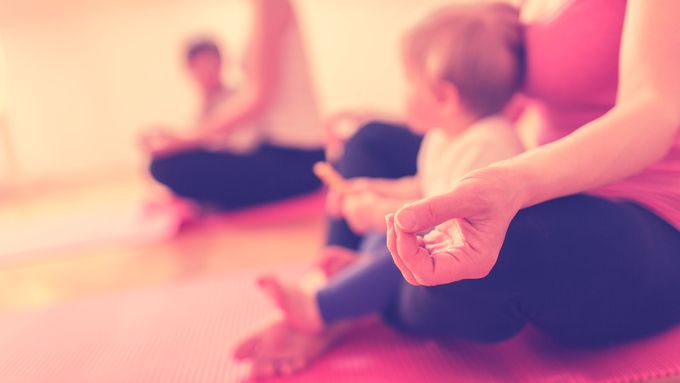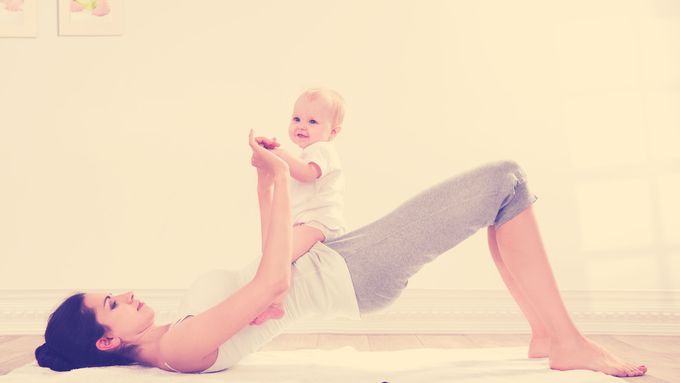
Let’s face it, when you’ve just given birth, knocking out a few burpees is probably the last thing on your mind. But once you’re starting to get back into the swing of ‘normal’ life, exercising is a great way of reminding yourself that not everything has to be different now you’re a mum.

Keeping fit and healthy has some great benefits. Yes, exercising can help you lose weight and get your pre-pregnancy figure back, but more importantly, becoming stronger and fitter means you can look after yourself and your baby better too.
Exercise can help with postnatal depression as you release ‘feel good’ hormones
“Exercise can also help with postnatal depression,” says Aileen Hill, an ante- and postnatal fitness specialist, and mother to two young girls. “Physically it’ll help as you’ll release more endorphins or ‘feel good’ hormones, but exercise can also provide a social network so you don’t feel like you’re isolated at home all day.”
Although exercising after having a baby has loads of benefits, there are a few things to take into account. Here are the answers to some common questions.
When is it safe for me to exercise after having a baby?
The general rule is that you need to be given the okay by your doctor before starting to exercise. This will usually be at your postnatal check-up, six weeks after a normal birth and 10 weeks after a caesarean.
The general rule is that you need to be given the okay by your doctor before starting to exercise
Having said that, there are basic exercises you can start to do within days of giving birth. Aileen recommends gentle pelvic floor exercises – squeezing the muscles as though you’re trying to prevent yourself having a wee.
Strengthening your pelvic floor helps with urinary incontinence (which you may experience after having children) and heightens sensitivity during sex.

What exercise should I be doing after giving birth?
When you’re ready to start exercising, the key is remembering – like pretty much everything connected with having a baby – that everyone is different. Listen to your body and exercise as little or as much as it’s telling you.
Aileen recommends exercising at 50% to 60% of your normal intensity
Aileen recommends exercising at 50% to 60% of your normal intensity and building up gradually so you can slowly get you body back to where you were before, without depleting your energy reserves.

The effects of relaxin can stay in your body for around six months after having a baby, and can affect the stability of your pelvic region
“In theory, you can do any type of exercise,” she says. “But I would avoid anything that involves big pelvic movements, like kickboxing. When you’re pregnant, your body produces a hormone called relaxin, which relaxes your ligaments, particularly around your pelvis, in preparation for giving birth.
“The effects of relaxin can stay in your body for around six months after having a baby – longer if you’re breastfeeding – and can affect the stability of your pelvic region, making you more susceptible to injury.”
Can I exercise if I had a caesarean?
Apart from waiting longer for the postnatal check up, take it gently when you do start exercising. Aileen recommends walking, core restoration and bodyweight exercises to help rehabilitate your muscles and build your strength.
You need to give your body time to heal, getting the foundation right and slowly regaining your strength
She advises avoiding running, jumping, heavy weight training, crunches, leg raises and other traditional ab exercises as you need to give your body time to heal, getting the foundation right and slowly regaining your strength again.
Is it OK to do sit-ups after having a baby?
“There are much better exercises for your abs than sit ups and planks,” says Aileen. “Pilates exercises such as heel slides and glute bridges are great for strengthening your core after giving birth as they work your deep core stabilisers and protect your back.

Before you do sit ups, make sure the gap between your abs is no more than two finger widths apart
But if you do want to do sit ups and planks, make sure the gap between your abs is no more than two finger widths apart.
“Abdominal separation, or diastasis recti – where the abs split during pregnancy as the uterus grows – is very common. You can measure the separation by seeing how many fingers you can fit into the gap, and do pelvic tilts to help close the separation as well as restore core strength.
“Doing sit ups before the gap is closed enough can result in bulging in your ab area, which can look like a pot belly or hernia. Not ideal.”
The NHS advises that if the gap is still obvious eight weeks after giving birth, your GP can refer you to a physio.
Err, what am I supposed to do with the baby while I exercise?
Postnatal fitness classes are a nice way to meet like-minded local mothers
“If you can’t find someone else to look after the baby while you work out, you could try speedwalking with the buggy or a buggy fitness class,” says Aileen. “Some elements will involve working with the buggy, while others are done with the babies watching from close by. It’s a nice way to meet like-minded local mothers, too.
“netmums has local noticeboards where you can find post-natal fitness classes in your area.”
Should I still exercise if the baby is keeping me up all night?
“You’ve got to look after yourself as a new mum, not least because you need to look after the baby,” says Aileen. “If you’re getting very little sleep, you’re better off saving your energy and recovering. However, sometimes exercise can help re-energise you. So if you feel up to it, why not?”